Our Universe by Jo Dunkley

Author:Jo Dunkley
Language: eng
Format: epub, pdf
ISBN: 9780241235904
Publisher: Penguin Books Ltd
Published: 2018-11-15T05:00:00+00:00
They had expected to see something quite different. Based on what could be seen of the stars and gas and dust, the galaxies seemed to have a bright and dense bulge of stars and gas at their middle, surrounded by the less-dense disc of stars. It was expected that the stars beyond the edge of the brightest central bulge should go around more and more slowly as they got further from the very heaviest part of the galaxy, the part in the middle.
That was the idea anyway, but it did not fit Rubin and Ford’s observations. The stars were still spinning round fast even at the very edge of the galaxy’s disc, and the ones further out were not getting any slower. Something else had to be going on. Rubin realized that it all made sense if there was some extra mass in the galaxy that stretched way beyond the stars. The predicted motion matched what was seen only if each galaxy was really a few times larger across than it looked, with as much as 90 per cent of its mass completely invisible. It seemed as if the stars were just the bright lights of the city, embedded in the dark countryside of a much vaster galaxy.
This was strange and surprising, and the idea was initially met with great scepticism when they published their results in 1976. Perhaps it should not have been so surprising; Rubin herself recalled that this matched the idea that Zwicky had come up with forty years earlier. This was the ‘dark matter’, stuff that we cannot see but that does feel gravity. Now there were 100 galaxies telling the same story about dark matter that the Coma galaxy cluster had hinted at all those years before, and it soon became clear that Rubin and Ford had found convincing evidence that it existed. At around the same time, Jerry Ostriker and Jim Peebles at Princeton University used computer simulations to show that galaxies without any invisible dark matter could not stay in the disc formation that we see. They needed dark matter to keep them from breaking up. Everything started to make sense, and Zwicky’s ‘dunkle Materie’ was alive again. What this stuff could be was a mystery: it is stuff that does not make any light, matter that we cannot see. It remains a mystery even today.
From what we can tell, there is dark matter in every galaxy, and in every group and cluster of galaxies. It also not only lies within and around those great cosmic objects but threads through space to form a great interconnected cosmic web. This web looks reminiscent of the neurons in our brains, blown up to gigantic proportions. It dominates over the visible stuff, with five times more mass in dark matter than regular atoms. The starlit parts of the galaxies are just the bright jewels in this larger dark network.
Our ability to understand and map dark matter is so much greater now than in Zwicky’s day, not only because of our more advanced telescopes, but because of computers.
Download
This site does not store any files on its server. We only index and link to content provided by other sites. Please contact the content providers to delete copyright contents if any and email us, we'll remove relevant links or contents immediately.
| Aeronautics & Astronautics | Astronomy |
| Astrophysics & Space Science | Comets, Meteors & Asteroids |
| Cosmology | Mars |
| Solar System | Star-Gazing |
| Telescopes | UFOs |
Tools of Titans by Timothy Ferriss(8306)
Turbulence by E. J. Noyes(7981)
Secrets of Antigravity Propulsion: Tesla, UFOs, and Classified Aerospace Technology by Ph.D. Paul A. Laviolette(5335)
Astrophysics for People in a Hurry by Neil DeGrasse Tyson(5152)
Room 212 by Kate Stewart(5073)
Design of Trajectory Optimization Approach for Space Maneuver Vehicle Skip Entry Problems by Runqi Chai & Al Savvaris & Antonios Tsourdos & Senchun Chai(5039)
Pale Blue Dot by Carl Sagan(4960)
The David Icke Guide to the Global Conspiracy (and how to end it) by David Icke(4658)
A Journey Through Divination and Astronomy by Publishing Pottermore(4364)
Goodbye Paradise(3763)
Apollo 8 by Jeffrey Kluger(3671)
COSMOS by Carl Sagan(3590)
The Five People You Meet in Heaven by Mitch Albom(3521)
Losing the Nobel Prize by Brian Keating(3519)
How to Read Water: Clues and Patterns from Puddles to the Sea (Natural Navigation) by Tristan Gooley(3434)
Brief Answers to the Big Questions by Stephen Hawking(3394)
How to Read Nature by Tristan Gooley(3294)
The Order of Time by Carlo Rovelli(3163)
A Brief History of Time by Stephen Hawking(2994)
